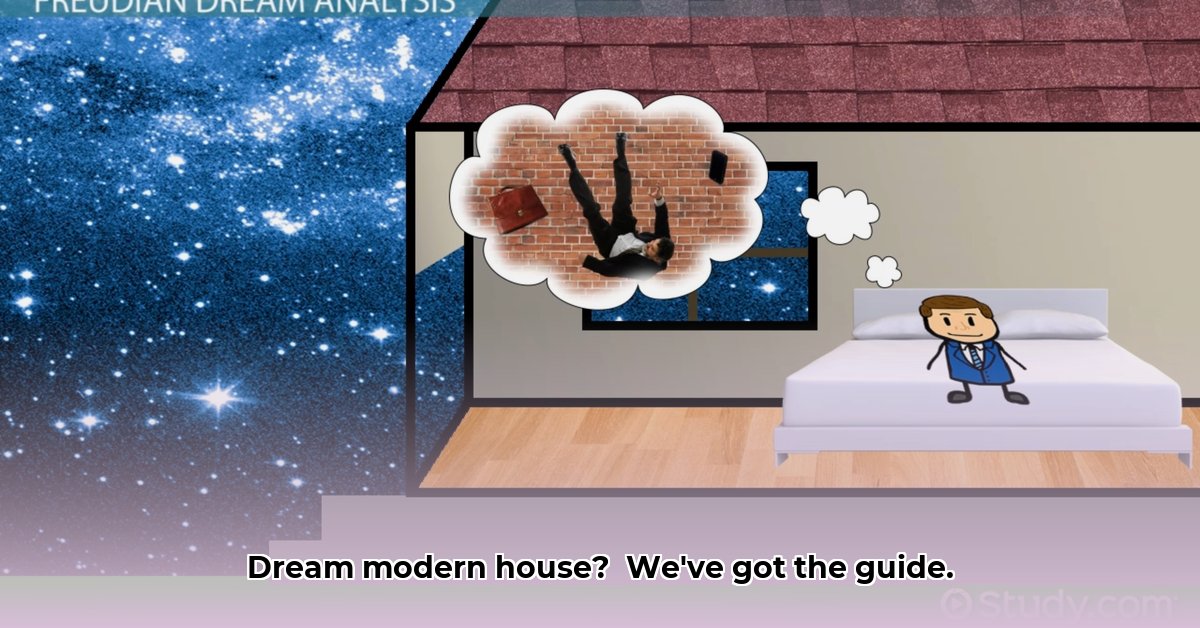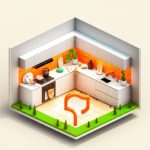Designing a dream modern home, characterized by sleek lines and sun-drenched spaces, requires careful planning. This comprehensive guide will provide a clear roadmap, covering everything from distinguishing modern from contemporary design to selecting optimal materials, securing an architect, and managing construction. Discover how to create a stylish, sustainable, and modern home, whether you’re exploring initial concepts or ready to start building. For more inspiration, check out this stunning modern home.
Understanding Modern House Design for Contemporary Living
Imagine a home filled with natural light, defined by clean lines and open layouts – a space both beautiful and functional. With the right approach, this vision can become a reality. We’ll delve into the essential aspects of modern house design, providing the knowledge and inspiration to create your dream home.
Defining Your Style: Modern vs. Contemporary Architecture
Before diving in, it’s important to clarify the difference between “modern” and “contemporary” architecture. Though often used interchangeably, they represent distinct styles. “Modern” refers to architectural styles originating from the early to mid-20th century, emphasizing clean lines, simple forms, functionality, and a rejection of excessive ornamentation. Examples include the Bauhaus movement and the International Style championed by architects like Le Corbusier.
“Contemporary,” however, reflects current design trends. It’s a fluid style incorporating elements from various periods, including modernism, mid-century modern, minimalism, and industrial design. A contemporary home might blend mid-century modern aesthetics with minimalist principles, resulting in a unique expression of personal style. Recognizing this distinction is crucial for refining your vision and creating a space that reflects your personality and lifestyle.
Key Design Elements of a Modern Home
Creating a truly exceptional modern home goes beyond aesthetics; it involves designing a space that enhances daily life.
- Open-Concept Living: Open floor plans eliminate cramped rooms and create a sense of spaciousness, allowing for seamless transitions between living areas. Imagine a home where the kitchen, dining room, and living room flow together, perfect for both entertaining and family life.
- Indoor-Outdoor Connection: Blurring the lines between interior and exterior spaces is a hallmark of modern design. Large windows, sliding glass doors, and expansive patios extend living areas outdoors, connecting you with nature. Imagine enjoying morning coffee on a sun-drenched patio or hosting a barbecue with guests effortlessly moving between indoors and outdoors.
- Natural Light Maximization: Strategic placement of windows and skylights optimizes natural light, which significantly impacts mood and well-being. Imagine a home filled with sunlight, creating an uplifting atmosphere throughout the day.
- Sustainable Design: Modern homes often incorporate sustainable features such as energy-efficient insulation, appliances, and solar panels, reducing energy consumption and minimizing environmental impact. This approach not only saves money but also contributes to a more sustainable lifestyle.
- Personalized Spaces: Tailoring your home to your specific needs and preferences is essential. Every detail, from the color palette to the layout, should reflect your unique personality. This level of personalization transforms a house into a home.
Overcoming Design and Construction Challenges
Constructing your dream modern house requires careful planning to address potential challenges:
- Budget Management: While modern design emphasizes minimalism, construction costs can vary. High-quality materials and specialized construction techniques may increase expenses. Obtain detailed estimates from multiple contractors and plan for contingencies to avoid financial surprises.
- Site Adaptation: Integrating your home with the surrounding environment is critical. Working with an experienced architect to address challenges such as narrow lots, steep slopes, or unusual terrain is essential. They can develop creative solutions that maximize the potential of the site.
- Accessibility and Future-Proofing: Consider long-term needs by incorporating features that support aging in place, such as single-story layouts, wider doorways, and accessible bathrooms. These features enhance the home’s value and ensure its continued comfort and functionality for years to come.
Choosing the Right Materials and Technologies
Selecting the appropriate materials and technologies significantly impacts the appearance and performance of your modern home.
| Material/Technology | Advantages | Potential Drawbacks |
|---|---|---|
| Sustainable Lumber | Eco-friendly, aesthetically pleasing, durable | May be more expensive than traditional lumber, availability may be limited depending on location |
| Reclaimed Materials | Environmentally responsible, adds unique character, often cost-effective | Sourcing can be time-consuming, condition and availability may vary, requires careful inspection |
| Smart Home Technology | Enhances security, improves energy efficiency, provides convenience and automation | Can have a high initial cost, may require professional installation, potential for technical issues and compatibility problems, privacy concerns may need consideration |
| High-Performance Windows | Superior insulation, optimized light control, reduces energy consumption, enhances comfort | Higher upfront cost compared to standard windows, may require specialized installation, long-term performance depends on proper maintenance |
| Concrete | Durable, versatile, modern aesthetic, can be polished and stained | Can be expensive, requires skilled labor for installation, poor insulation properties unless properly treated |
| Metal Siding | Durable, low maintenance, modern aesthetic, fire resistant | Can be expensive, may dent or scratch, can be noisy during rain |
| Integrated Solar Panels | Renewable energy source, reduces electricity bills, sustainable | High initial cost, dependent on sunlight availability, may affect roof aesthetics, requires professional installation and maintenance |
| Rainwater Harvesting Systems | Conserves water, reduces water bills, environmentally friendly | Requires storage tanks and filtration systems, dependent on rainfall, may not be suitable for all climates, requires regular maintenance |
Building Your Dream: A Step-by-Step Guide
Follow these steps to turn your dream modern house into a reality:
Step 1: Extensive Research and Inspiration: Explore architectural magazines, online resources such as Dwell and ArchDaily, and visit modern homes to gather ideas and inspiration. Define your personal style and preferences by creating a mood board.
Step 2: Assemble Your Project Team: Select an architect and builder who understand your vision and have experience with modern construction. Check references, review portfolios, and ensure clear communication.
Step 3: Detailed Design and Planning: Collaborate with your architect to develop comprehensive plans that align with your vision, budget, and local building codes. Obtain necessary permits and approvals.
Step 4: Construction and Project Management: Oversee the construction process closely, maintaining open communication with your builder. Regularly inspect the work and address any issues promptly.
Building a dream modern house is about crafting a space that enhances your life and reflects your unique style. Embrace the process and enjoy creating your ideal living environment.
Modern vs. Contemporary House Design Costs: A Comparative Analysis
Key Considerations:
- While modern and contemporary styles share elements such as open floor plans and emphasis on natural light, their aesthetic philosophies and executions differ significantly.
- Modern design, rooted in mid-20th-century principles, emphasizes functionality, clean lines, and natural materials. Contemporary design incorporates diverse materials and embraces asymmetry.
- Comparing modern vs. contemporary house design costs requires a detailed analysis of materials, labor, and specialized techniques. Contemporary designs often require higher precision, potentially increasing costs.
- Understanding these differences is crucial for budgeting and managing expectations.
- Consulting architects experienced in both styles ensures informed decision-making.
Style Definition: Modern vs. Contemporary
Distinguishing between modern and contemporary design clarifies budgetary considerations. Modern design embraces sleek lines and minimalism, exemplified by iconic furniture pieces like the Eames chair. Contemporary design is more fluid, incorporating current trends and materials such as recycled elements or bold color palettes.
Cost Implications of Key Design Features
Both styles emphasize open floor plans and natural light. However, the approach to achieving these features differs. Modern designs often use regularly shaped windows, while contemporary designs may incorporate uniquely shaped or strategically placed windows, increasing material and labor expenses. Modern design is akin to a well-tailored suit, while contemporary design resembles a custom-designed gown.
Material Considerations
Modern homes often feature traditional materials like wood and stone, which may have lower upfront costs but require more maintenance. Contemporary homes may utilize experimental, high-tech, or sustainably sourced materials, which are initially costlier but potentially more durable and environmentally friendly.
Budget Navigation
Comparing modern vs. contemporary house design costs requires a breakdown of individual elements:
- Foundation and Structure: Complex angles and curves in contemporary designs increase construction time and labor costs.
- Materials: The choice of materials significantly impacts overall costs.
- Finishes: Custom finishes and bespoke elements in contemporary designs add to the price.
- Labor: Specialized skills for certain design elements increase labor costs.
Balancing Aesthetics and Budget
Sustainable building materials are increasingly popular. Recycled materials and energy-efficient technologies can be integrated for long-term savings. Research and compare costs to make informed decisions that balance aesthetics and budget.
- Glass Tile Shower Ideas to Create a Stunning Bathroom Space - December 7, 2025
- Glass Wall Tile Ideas for Kitchens and Bathrooms - December 6, 2025
- Glass Tile Bathroom: Create a Beautiful, Easy-Clean Space - December 5, 2025










